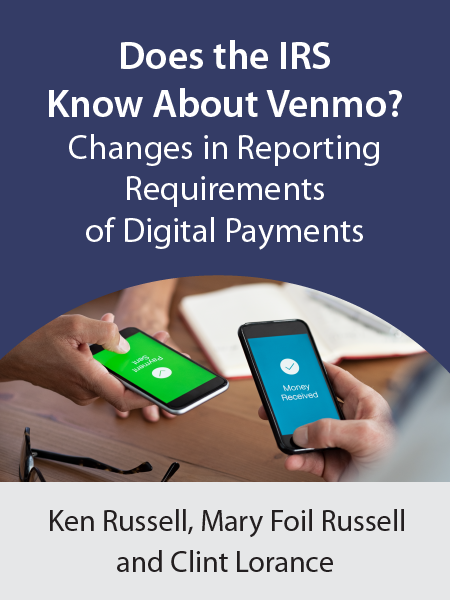
A major convenience in smartphone technology is the availability of third-party payment networks like Venmo and PayPal, which replace payments by cash, check, or debit card. The IRS calls these transactions, third-party network transactions (TPNTs) and the entities making the payments third-party settlement organizations (TPSOs).1
TPSOs have a duty to report certain TPNTs to the IRS. At its inception, the minimum reporting threshold was $20,000 but in 2021, that threshold decreased to $600.2 As a result, many more taxpayers were to receive a Form 1099-K for tax year 2022. In Notice 2023-10, published on January 3, 2023, the IRS delayed the duty of TPSOs to issue notice of TPNTs at this new lower threshold.3 Even with the IRS delay, taxpayers started to see some of these Form 1099-Ks in January. Attorneys and tax professionals should understand the status of the requirements and be prepared to address the taxability of TPNTs.
TPNTs EXPLAINED
A TPNT is a convenient method of moving money. In the not-so-distant past, paying a bill or reimbursing a friend could involve mailing a paper check, with the payee cashing the check days later. By using a TPSO, such as Apple Pay, Venmo, or PayPal, that same payment can be made within minutes.4 A parent, for instance, who wishes to send their far-flung college student some spending money, can do so instantly with just a few taps on their iPhone. A festivalgoer may pay a vendor with a smartphone and have the convenience of not carrying cash. These transactions solve issues of time, distance, and security.
Roughly 79 percent of Americans surveyed in 2020 said they use a TPSO on their mobile phone to send
and receive money.5 Additionally, 43 percent of respondents said they use these services to repay
friends and family members, with another 40 percent using these services to pay bills.6 But must
these TPNTs be accounted for at tax time? As often happens, government struggles to maintain pace
with technological developments. The challenge for the IRS, and, in turn, for taxpayers, is accounting for
those TPNTs that are taxable.
THRESHOLD FOR REPORTING TPNT
Since 2011, the IRS mandated that a TPSO send to taxpayers and the IRS a reporting form called a 1099-K for any gross payment which “exceeds $20,000,” and the aggregate “number of such transactions…exceeds 200.”7 Given this rather high threshold, most taxpayers paid little attention to the TPNTs they made or received throughout the tax year. A provision in the American Rescue Plan Act of 2021 changed the reporting significantly and some states have adopted the same lower threshold.8 Instead of the $20,000 reporting threshold that had existed since 2011,9 the threshold became a mere $600 regardless of the number of transactions.10 Because of the confusion and controversy over the reporting changes, the IRS issued guidance, delaying the threshold change for tax year 2022. The IRS views calendar year 2022 “as a transition period for purposes of IRS enforcement and administration of the modified de minimis exception for … third party network transactions.”11
Although the IRS guidance states that TPSOs will not be penalized for 2022 reporting, taxpayers have started seeing 1099-Ks under the new thresholds. Regardless of receipt of a 1099-K, if the amounts received by a taxpayer as a TPNT were for goods or services, those amounts are income. Below are some reminders and helpful tips in assessing tax liability for money received through a TPNT.
Documentation regarding goods or services
Many business taxpayers should be familiar with a 1099-K from a TPSO. If the business received over
200 TPNTs and $20,000 in any year since 2011, the business already has been receiving 1099-Ks. Small businesses, however, may be receiving a 1099-K for the first time. The taxpayer most likely to be unfamiliar with a 1099-K is an individual taxpayer who received money through a TPSO in exchange for “goods and services.”
To be clear, if the TPNT is money from friends and family (e.g., for repayment of an expense or to split the check at dinner), the taxpayer need not include the amount as income. Gifts do not need to be included either. Nevertheless, if the payor categorized an amount as “goods or services,” the payee taxpayer must be able to document that the payment was for some other purpose in order to exclude that amount as income.
Almost immediately following the threshold change, TPSOs began to educate their users of the change on their respective websites. Venmo, for example, states the following on its customer website, included in part, with emphasis added:
- What makes a payment goods and services?
When sending money on Venmo, users can choose to tag a payment as being for “goods and services”.
Whether it’s for a product you sell, a service you provide, or even an old couch you don’t want anymore, the person paying for the item or service can decide whether to tag the payment.
All payments sent to business profiles on Venmo are tagged as purchases automatically and are therefore considered to be for goods and services.12
Venmo’s summary above addresses the key parts of this law most likely to cause confusion: Venmo will rely on the payor’s “tag” on the payment to determine what to report on the 1099-K.13
Savvy taxpayers should keep files with backup documentation. If the money was received for goods and services, it should be marked as such in the taxpayer’s records, in much the same way as the Venmo recommendation above. If the taxpayer intends to dispute that a payment was for goods or services, the taxpayer should have receipts or some form of documentation to show what the payment was actually intended for.
CLICK HERE to read the full article, which was originally published in ALI CLE’s The Practical Lawyer.
The Practical Lawyer

Subscribe to the print or digital version of The Practical Lawyer today.
